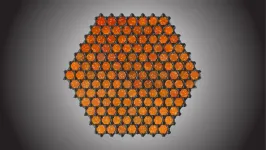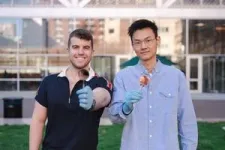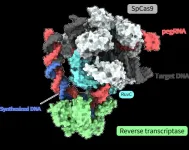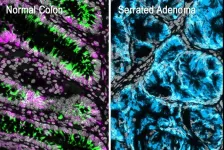(Press-News.org) Graphene has been called “the wonder material of the 21st century.” Since its discovery in 2004, the material—a single layer of carbon atoms—has been touted for its host of unique properties, which include ultra-high electrical conductivity and remarkable tensile strength. It has the potential to transform electronics, energy storage, sensors, biomedical devices, and more. But graphene has had a dirty little secret: it's dirty.
Now, engineers at Columbia University and colleagues at the University of Montreal and the National Institute of Standards and Technology are poised to clean things up with an oxygen-free chemical vapor deposition (OF-CVD) method that can create high-quality graphene samples at scale. Their work, published May 29 in Nature, directly demonstrates how trace oxygen affects the growth rate of graphene and identifies the link between oxygen and graphene quality for the first time.
“We show that eliminating virtually all oxygen from the growth process is the key to achieving reproducible, high-quality CVD graphene synthesis,” said senior author James Hone, Wang Fong-Jen Professor of Mechanical Engineering at Columbia Engineering. “This is a milestone towards large-scale production of graphene.”
Graphene has historically been synthesized in one of two ways. There’s the “scotch-tape” method, in which individual layers are peeled from a bulk sample of graphite (the same material you’ll find in pencil lead) using household tape. Such exfoliated samples can be quite clean and free from impurities that would otherwise interfere with graphene’s desirable properties. However, they tend to be too small—just a few tens of micrometers across–for industrial-scale applications and, thus, better suited for lab research.
To move from lab explorations to real-world applications, researchers developed a method to synthesize large-area graphene about 15 years ago. This process, known as CVD growth, passes a carbon-containing gas, such as methane, over a copper surface at a temperature high enough (about 1000 °C) that the methane breaks apart and the carbon atoms rearrange to form a single honeycomb-shaped layer of graphene. CVD growth can be scaled up to create graphene samples that are centimeters or even meters in size. However, despite years of effort from research groups around the world, CVD-synthesized samples have suffered from problems with reproducibility and variable quality.
The issue was oxygen. In prior publications, co-authors Richard Martel and Pierre Levesque from Montreal had shown that trace amounts of oxygen can slow the growth process and even etch the graphene away. So, about six years ago, Christopher DiMarco, GSAS’19, designed and built a CVD growth system in which the amount of oxygen introduced during the deposition process could be carefully controlled.
Current PhD students Xingzhou Yan and Jacob Amontree continued DiMarco’s work and further improved the growth system. They found that when trace oxygen was eliminated, CVD growth was much faster—and gave the same results every time. They also studied the kinetics of oxygen-free CVD graphene growth and found that a simple model could predict growth rate over a range of different parameters, including gas pressure and temperature.
The quality of the OF-CVD-grown samples proved virtually identical to that of exfoliated graphene. In collaboration with colleagues in Columbia’s physics department, their graphene displayed striking evidence for the fractional quantum Hall effect under magnetic fields, a quantum phenomenon that had previously only been observed in ultrahigh-quality, two-dimensional electrical systems.
From here, the team plans to develop a method to cleanly transfer their high-quality graphene from the metal growth catalyst to other functional substrates such as silicon — the final piece of the puzzle to take full advantage of this wonder material.
“We both became fascinated by graphene and its potential as undergraduates,” Amontree and Yan said. “We conducted countless experiments and synthesized thousands of samples over the past four years of our PhDs. Seeing this study finally come to fruition is a dream come true.”
Additional Information:
The work was initiated by Mechanical Engineering PhD student Christopher DiMarco and continued by current PhD students Xingzhou Yan and Jacob Amontree, who have spent the past four years modifying the system and conducting the experiments that are shown in the paper. The work was supervised by Prof. James Hone (Mechanical Engineering) and co-led by Prof. Katayun Barmak (APAM), with Prof. Abhay Pasupathy and Prof. Cory Dean (Physics) providing key contributions. Postdoc Madisen Holbrook (Physics) imaged the graphene atomic lattice, and PhD students Christian Cupo and Zhiying Wang (MECE) helped with data analysis and measurements. Physics PhD students Jordan Pack, Dihao Sun, and Adam Biachhi performed key electrical measurements.
Richard Martel and Pierre Levesque at the University of Montreal helped guide the research and test the reproducibility of the results. Dr. Angela Hight-Walker’s team at the National Institute for Standards and Technology, in particular Dr. Tehseen Adel and Dr. Charlezetta Wilson-Stokes, characterized the graphene.
END
In a study of Medicare beneficiaries, researchers from Brigham and Women’s Hospital found that one year after hospitalization for heart failure, 6 percent of patients had progressed to dialysis.
KEY TAKEAWAYS
Study led by Brigham researchers found that among older adults hospitalized for heart failure, nearly 3 in 4 were discharged with reduced kidney function.
Lower kidney function was associated with substantially higher risk of kidney complications and other adverse clinical outcomes among older adults, with more than 1 in 20 progressing to dialysis within one year after heart failure hospitalization.
These findings emphasize the need ...
Joint research led by Yutaro Shuto, Ryoya Nakagawa, and Osamu Nureki of the University of Tokyo determined the spatial structure of various processes of a novel gene-editing tool called “prime editor.” Functional analysis based on these structures also revealed how a “prime editor” could achieve reverse transcription, synthesizing DNA from RNA, without “cutting” both strands of the double helix. Clarifying these molecular mechanisms contributes greatly to designing gene-editing tools accurate enough for gene therapy treatments. The findings were published in the journal Nature.
The ...
Research led by Weill Cornell Medicine provides new evidence that most colorectal cancers begin with the loss of intestinal stem cells, even before cancer-causing genetic alterations appear. The results, published on May 29 in Developmental Cell, overturn the prevailing theory for colorectal tumor initiation and suggest new ways to diagnose the disease before it has a chance to become established.
“Colorectal cancer is very, very heterogeneous, which has made it difficult for many years to classify these tumors in order to inform therapy,” said senior author Dr. ...
Researchers at Baylor College of Medicine and collaborating institutions have discovered that a protein called hnRNPM helps protect the integrity of the process cells use to make proteins. hnRNPM works by preventing the cell from making mistakes while it is putting together the different components leading to newly produced proteins. In cancer cells, loss of hnRNPM triggers an interferon immune response, suggesting that this protein may hold clinical promise. The findings appeared in Molecular Cell.
“Synthesizing a protein is like putting together the different parts of a machine. If during the assembly process parts that do not belong are incorporated ...
ANN ARBOR, Mich. – When a child peruses YouTube, the content recommended to them is not always age appropriate, a new study suggests.
Researchers mimicked search behaviors of children using popular search terms, such as memes, Minecraft and Fortnite, and captured video thumbnails recommended at the end of each video.
Among the 2,880 thumbnails analyzed, many contained problematic click bait, such as violence or frightening images, according to the Michigan Medicine led research in JAMA Network Open.
“Children spend a significant amount of time on free video sharing platforms that ...
CAMBRIDGE, MA — Quantum computers hold the promise of being able to quickly solve extremely complex problems that might take the world’s most powerful supercomputer decades to crack.
But achieving that performance involves building a system with millions of interconnected building blocks called qubits. Making and controlling so many qubits in a hardware architecture is an enormous challenge that scientists around the world are striving to meet.
Toward this goal, researchers at MIT and MITRE have demonstrated a scalable, modular hardware platform that ...
Researchers from Lancaster University and Radboud University Nijmegen have managed to generate propagating spin waves at the nanoscale and discovered a novel pathway to modulate and amplify them.
Their discovery, published in Nature, could pave the way for the development of dissipation free quantum information technologies. As the spin waves do not involve electric currents these chips will be free from associated losses of energy.
The rapidly growing popularity of artificial intelligence comes with an increasing desire for fast and energy efficient computing devices and calls for novel ...
Researchers from Tokyo Medical and Dental University (TMDU) find that donor keratinocytes injected into mouse embryos form sheets of epidermis that can be used as autologous skin grafts
Tokyo, Japan – Skin grafting is an essential procedure used to treat severe skin wounds. In the case of extensive wounds, however, it can be challenging to harvest enough donor skin, and generating artificial skin substitutes that include hair follicles and sweat glands and can engraft on deep wounds has not been successful. Now, researchers from Japan report a new way to “grow your own” donor skin that could help improve the success of skin graft generation.
In a study published last ...
BEER-SHEVA, Israel, May 29, 2024 – A recent collaborative research endeavor, published in the prestigious Cell Press journal Cell Reports Medicine, highlights a promising therapeutic avenue for amyotrophic lateral sclerosis (ALS). Led by researchers from Ben-Gurion University of the Negev in conjunction with counterparts from Germany, the USA, and Canada, the study delves into the potential of augmenting macrophage migration inhibitory factor (MIF) protein levels as a novel approach to tackling ALS.
ALS, often referred to as Lou Gehrig's disease, is a devastating neurodegenerative condition characterized by the progressive loss of motor neurons, leading to muscle ...
Women’s participation in politics is essential to advancing women’s rights and contributes to countries’ overall stability and economic prosperity. According to a 2023 report by UN Women and the Inter-Parliamentary Union, one-fourth of parliamentary positions worldwide are held by women. Although current representation is still far from equal, it represents a significant increase over the last 20 years.
However, a new paper from Washington University in St. Louis — published ...







